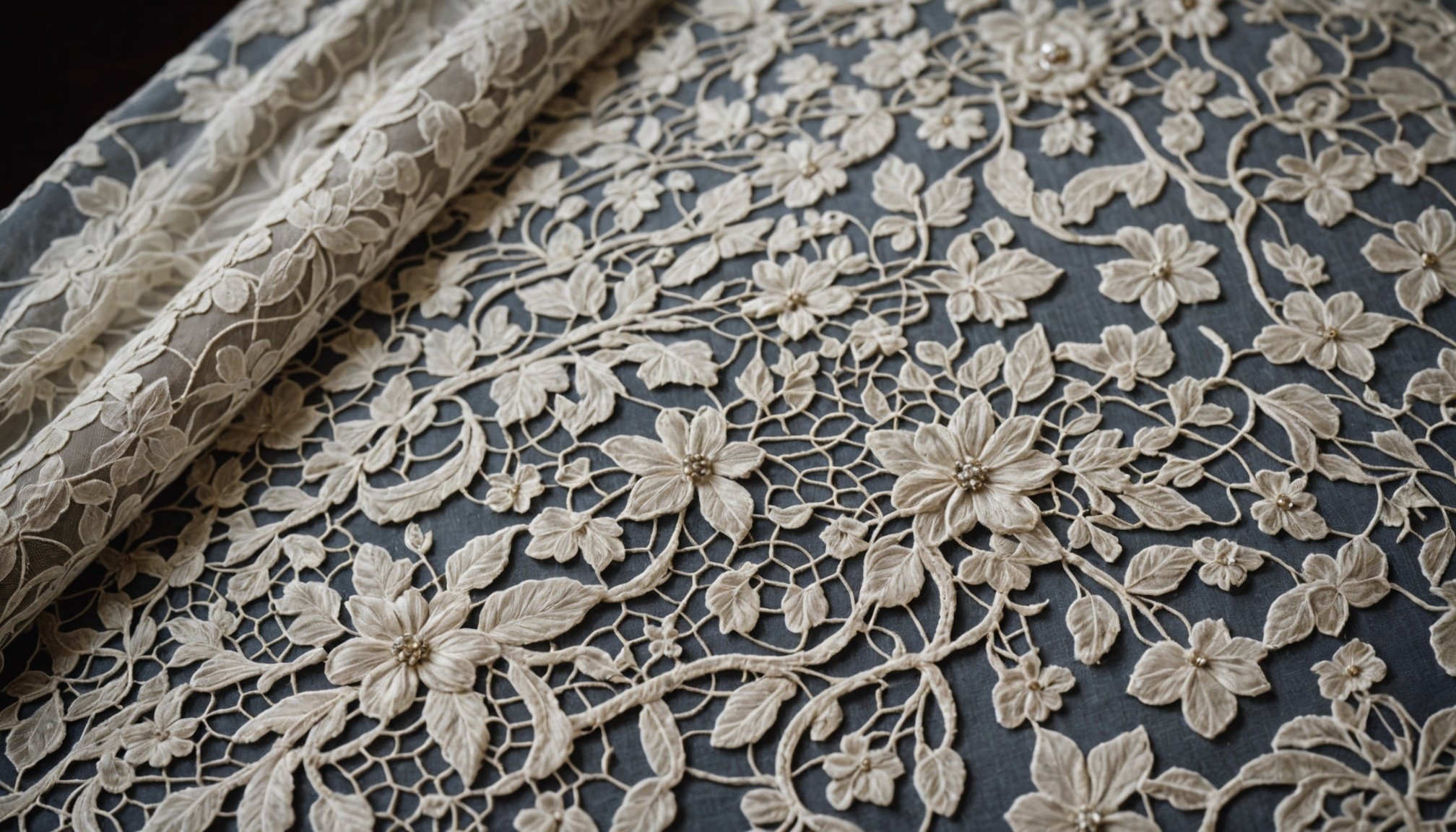Overview of Antique Lace for Bridal Gowns
Antique bridal lace infuses wedding attire with elegance and history. This delicate fabric has played a significant role in bridal fashion, adding sophistication and charm. Defined by its age and intricate craftsmanship, antique lace varies in style, from the fine, delicate Chantilly lace to the robust and patterned Venetian lace.
The history of lace in wedding attire can be traced back to the 16th century, when it became a symbol of wealth and status. Throughout the centuries, lace styles evolved, with each era contributing unique designs and techniques. In the Edwardian age, for example, lace was extensively used in bridal gowns, showcasing elaborate details and quality workmanship.
This might interest you : Find your ideal jewelry box: styles, materials, and tips
The allure of using antique lace in modern bridal designs lies in its ability to weave the past with the present. Brides of today appreciate vintage lace for its uniqueness and the nostalgic touch it lends to their attire. Incorporating antique lace into contemporary designs not only honours traditional craftsmanship but also provides a distinctive look that sets a bride apart. Whether used in veils, sleeves, or overlays, antique lace continues to be a treasured element in bridal fashion.
Sourcing Antique Lace in the UK
Finding antique lace in the UK has become an art form for enthusiasts and collectors. There are various avenues to explore, including specialty shops and vibrant vintage markets. To begin your search, consider visiting historic lace-producing cities like Nottingham, renowned for its rich textile heritage and specialist boutiques offering exquisite lace finds.
In parallel : Discover Top-Rated Shoe Repair Specialists in Birmingham: Your Guide to Quality Service
In addition, the UK boasts a wealth of vintage markets such as London’s Portobello Road Market and Spitalfields Market, where antique lace dealers often display exceptional pieces. These markets offer the perfect opportunity to examine lace up-close and negotiate directly with sellers.
For those preferring a modern approach, several online platforms and auctions provide a comprehensive selection of antique lace for enthusiasts who may not have immediate access to physical locations. Websites like eBay UK and Etsy offer a broad array of lace pieces, catering to various tastes and budgets.
For a deeper dive into lace history and acquisition, attending lace fairs and vintage exhibitions can be invaluable. These events not only showcase stunning lace samples but also facilitate networking with knowledgeable collectors and vendors, enhancing both your understanding and collection of antique lace.
Identifying High-Quality Antique Lace
Recognizing quality lace begins with understanding its defining characteristics. Authentic antique lace typically showcases intricate craftsmanship and unique patterns not easily found in modern reproductions. High-quality pieces often feature finely woven threads, indicating meticulous attention to detail by skilled artisans of the past.
Common Types and Unique Features
There are several types of lace each with their own unique attributes. For instance, Chantilly lace is renowned for its delicacy and floral patterns, typically executed in black silk threads. On the other hand, Valenciennes lace is characterized by its lightness and continuous bobbin lace patterns. Understanding the nuances in these textures and designs can guide collectors towards genuine antique lace acquisitions.
Lace patterns also offer clues to a lace’s origin and authenticity. Certain motifs can be traced back to specific regions, often tied to historical periods in fashion evolution. These patterns are not only ornamental but can also reveal the method of production, whether needle or bobbin lace.
Additionally, assessing the condition and craftsmanship is crucial. Fine lace should have minimal wear, with intact threads and no visible repairs disrupting the pattern. An eye for these details can ensure the discovery of authentic and high-quality antique lace treasures.
Incorporating Antique Lace into Bridal Designs
Antique lace designs offer a timeless and elegant touch to bridal gowns, providing countless bridal gown inspiration. Integrating antique lace creatively can elevate a gown’s sophistication, whether it’s used to embellish sleeves, veils, or bodices. Consider incorporating antique lace into different sections of the gown, such as the hem or train, to add a unique flair.
When customizing antique lace for a bridal gown, modern twists can be achieved by dyeing the lace to match the gown’s color scheme, or layering it with contemporary fabrics like satin or tulle. Tailoring the lace’s placement strategically can also highlight the bride’s silhouette, enhancing the gown’s overall appeal.
Several successfully executed case studies highlight the potential of antique lace in bridal fashion. In one instance, a designer transformed a vintage lace tablecloth into a breathtaking bodice, beautifully merging history with modern elegance. Another example involved using lace from an heirloom wedding dress to create intricate appliques on a new gown, preserving sentimental value while adding a unique design feature.
Experimenting with antique lace designs allows brides to connect with tradition while confidently showcasing their unique style on their special day.
Care Instructions for Antique Lace
Caring for antique lace requires understanding its delicate nature and implementing effective lace care tips. Begin by considering the appropriate cleaning methods. Always hand wash antique lace with mild detergents specifically designed for vintage fabrics. This gentle approach prevents damage and extends the lifespan of the lace.
When it comes to storage, proper techniques are vital for preserving lace. Store the lace in a cool, dry place, preferably in acid-free tissue paper to prevent yellowing and deterioration. Avoid using plastic bags as they can trap moisture and lead to mildew.
Selecting the right products is crucial for maintaining the integrity of vintage lace. Use products like fabric stabilizers sparingly to provide additional support without compromising the fabric. It’s essential to choose those specifically manufactured for antique textiles.
Be aware of common pitfalls in antique lace care. Avoid using harsh chemicals or bleach, even if the lace appears heavily stained; these can cause irreparable damage. Never dry it under direct sunlight, as this can cause fading and weaken the fibres.
By adhering to these tips, you can ensure the beauty and history of your antique lace lasts for generations to come.
Visual Inspiration and Resources
Finding the perfect design inspiration for antique lace can be a joyful journey. Curated visual galleries abound with stunning examples of this timeless material, drawing antique lace enthusiasts to explore its potential in bridal fashions. These collections feature intricate patterns and delicate craftsmanship, offering endless ideas for incorporating lace into your outfit.
For those seeking a more structured bridal lookbook, resources such as books on lace and bridal fashion serve as invaluable guides. These lookbooks offer a combination of historical insights and modern interpretations, making it easier to envision how antique lace can transform a gown into a piece of art.
Stories from brides and designers who have incorporated antique lace into their gowns bring these concepts to life. Whether it’s a family heirloom repurposed for a wedding dress or a designer’s unique take on traditional motifs, these personal anecdotes provide a deeper connection to the fabric and its possibilities. Engaging with such stories not only provides inspiration but also reassures brides and designers about the beauty and elegance that antique lace brings to bridal wear.











